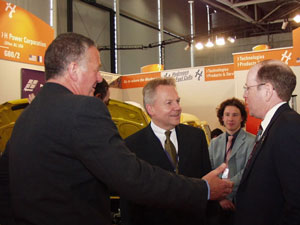The German Railway (DB) is giving a clean signal:
Launch for a emission-free railway system
On the traditional German railway site Kirchmöser in Brandenburg / Havel, one of the most modern centre of excellence for rail technology will be established. Dr. Ruediger Grube, CEO of Deutsche Bahn and representatives of nine industrial groups as well as two research intitutions confirmed this move in mid-August 2009 at a launch event for the DB Eco Rail Center.

Dr. Ruediger Grube, then still in his capacity as a board member of DaimlerChryler AG, at the Hannover Fair 2002. See you all in 2010! Photo: Team Arno A. Evers FAIR-PR |
DB-Chairman Dr. Ruediger Grube said in Kirchmöser: "Especially in economically difficult times, it is important, to set a sign of new beginnings and to bring in investment for the future. The long-term goal is to realize an emission-free rail travel on non-electrical railroads and to be able to offer an overall environmentally friendly transport chain. Here, the industrial partners will jointly develop components from their labs and put them on the rail."
Wolfgang Tiefensee, Federal Minister, Federal Ministry of Transport, Building and Urban Affairs, Berlin, Germany, said: "We are moving towards a new mobile world. Germany, with his excellent ideas, should be a new spearhead here. The railway is one of the most environmentally friendly means of transport. In order to remain this also in the future, it must cope the new challenges and bring innovative propulsion technologies with minimal emissions to the railways. The close cooperation between the rail industry and Deutsche Bahn AG is an important step in the right direction." At the end a rail transport with "zero emissions" should be established. The joint project of the Deutsche Bahn together with large corporations like Siemens, Bombardier and Linde is still in the initial phase. The DB Rail Eco Center will be a "decisive contribution to reduce CO2 emissions". That sounds good, however, you should take a close look, how the details are going to be realized.
The attentive reader will note that words, such as hydrogen and fuel cells (H2/FC) are missing here. Where is the lobbying for the application of these technologies? Where is the truly renewable production of hydrogen? Where is the clever use of all functions of fuel cell systems? How much time is available for us to implement and introduce H2 and FC on a worldwide scale? The author of this EnergyIdea wondering about these questions.
Dr. Grube visited, then in his capacity as a board member of DaimlerChrysler AG, the Group Exhibition on Hydrogen and Fuel Cells at the Hannover Fair 2002. Here he spoke with many of the international exhibitors (our photo) and answered questions in the technical forum, moderated by Ulrich (Ulli) Walter of Team Arno A. Evers FAIR-PR. Recently, Dr. Grube confirmed another visit to the Group Exhibit H2/FC at the Hannover Fair 2010, April 19-23.
List of Partners DB Rail Eco Center, Brandenburg-Kirchmöser:
Alstom Transport Germany GmbH, Salzgitter, Germany, Bombardier Transportation GmbH, Berlin, German Bahn AG, Berlin, Deutsches Zentrum für Luft-und Raumfahrt eV (DLR), Cologne; ENERTRAG Aktiengesellschaft, Gut Dauerthal, Fachhochschule Brandenburg, Brandenburg an der Havel, Linde AG, Munich, Siemens AG, Berlin and Munich; Solon SE, Berlin; Tognum AG, Friedrichshafen; Association of Railway Industry in Germany eV, Berlin, Voith Turbo GmbH & Co . KG, Heidenheim.
Own high-voltage rail network
The German Railway has its own 110-kV high-voltage network with a total length of approximately 7400 kilometers. It carries the electricity which is feed in at 61 points, to 164 railway substations, were it is suppling the 15 kV overhead lines. For historical reasons, the train electricty in Germany works on a frequency of 16.7 hertz and in single phase. The German railway also has its own power plants to generate electricity. Increasingly, she also uses electricity from the public network, to supply roughly 25,000 daily trains and other facilities. The three-phase 50-Hertz electricity supply of the public grid will be converted, - similar to the high-voltage DC transmission (HVDC) between different systems, - via an intermediate DC circuit into AC railway electricity. The railway electricity network has a particularly high regulation power need, as eg fast speed trains (ICE`s) require an output of nearly 10 MW. By driving, within a few seconds, load variations of up to 300 MW occur, the equal amount which is needed to switch on 2 million TV devices. These experiences could e.g. be needed by other power grid operators to help them to adjust the current supply fluctuations in the fluctuating supply of renewable electricity into the grid. Under the umbrella of the DB Netze AG, DB Energie GmbH, based in Frankfurt, secures the cost-effective power supply for the electric train system in Germany. The company is also responsible for the supply of diesel fuel for the operation of trains and for 50 Hz lighting and power supply to the stationary DB installations. In 2009, the DB Energie GmbH, exhibited for the first time at the Hanover Fair, as part of the leading international trade fair "Energy" in Hall 13. Exhibiting sectors were "energy services" and "optimization of energy and fuel costs."
Links to the News:
Date: 25.08.2009 |
